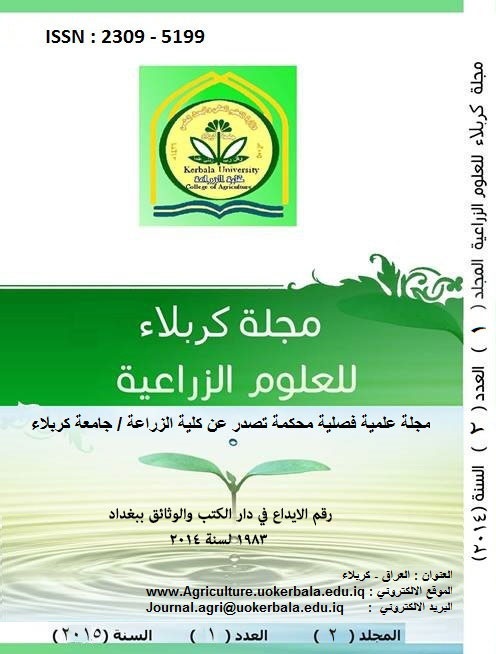Biological control by Pseudomonas fluorescens and Azotobacter chroococcum bacteria to Fusarium chlamydosporum caused yellowing and stiffness of the detached leaves of date palm growth summit
DOI:
https://doi.org/10.59658/jkas.v2i1.458Keywords:
Fusarium chlamydosporum , Date palm diseases , RhizobacteriaAbstract
The objective of this study was to isolate and identify the pathogen cause yellowing and stiffness of the detached leaves of date palm growth summit.Results of isolation from roots showed presence of the fungal Fusarium chlamydosporum in palm trees of Babylon and Karbala provinces , this is the first record of the fungus F.chlamydosporum on palm trees in Iraq. The initial detection of pathogenic isolates of F.chlamydosporum using red radish seeds showed that all isolates tested were pathogenic and germination Percentage ranged between 12 – 27% , and the results show the effect of isolate of F.chlamydosporum (F.c3) in the severity of injury of palm seedlings 75 days old under the lathe house conditions,the isolate(F.c3) gave a significantly rise in the severity of the injury reached to 93.75% compared to comparison which was 0.0%,the treatment of addition bacteria Pseudomonas fluorescens and bacteria Azotobacter chroococcum from concentration 5 x 107 , 6.5 x 106 (colonial unit / Ml) respectively, achieved protection of palm seedlings from injury with the isolate (F.c3) under lathe house conditions, resulted in the treatment of bacteria P.fluorescens and A.chroococcum to a reduction in the severity of the injury reached to 6.25% and 18.75% respectively compared to the treatment (pathogenic fungal only) that the severity of injury reach to 93.75%.
Downloads
Published
How to Cite
Issue
Section
License
Copyright (c) 2015 Copyright (c) 2024 is the Author's article. Published by the Journal of Kerbala for Agricultural Sciences under a CC BY 4.0 license

This work is licensed under a Creative Commons Attribution 4.0 International License.
Licensing Terms
All articles are published under a Creative Commons License and will be directed to the Creative Commons Attribution 4.0 International License (CC BY 4.0) That permits use, distribution, and reproduction in any medium, provided the original work is properly cited. This license also allows the work to be used for commercial purposes.
Use by both non-commercial and commercial users
This content is licensed under a Creative Commons Attribution 4.0 International (CC BY 4.0) license, permitting use by both non-commercial and commercial users. Individual users may access, download, copy, display, and redistribute the articles to colleagues, as well as adapt, translate, and text- and data-mine the content, subject to the following conditions:
- The author's moral rights, including the right of attribution and the right to protect their work from derogatory treatment, are respected.
- Where content in the article is identified as belonging to a third party, users must ensure that any reuse complies with the copyright policies of the owner of that content.
- If the article content is reused for research or educational purposes, users should maintain a link to the appropriate bibliographic citation, including the DOI and a link to the published version on the journal's website.

